 |

For further MBL News and Media Information, contact the MBL Communications Office at (508) 289-7423 or e-mail us at comm@mbl.edu
Ocean Microbe Census Discovers Diverse World of Rare Bacteria
New DNA Sequencing Tools Deployed by MBL Scientists Yield Startling Insights, Questions about Role of Vast Genomic Diversity and Ecological Change over Millions of Years; 20,000+ Kinds of Bacteria Found in One Liter of Seawater
MBL, Woods Hole, MA - A startling revelation about the number of different kinds of bacteria in the deep-sea raises fundamental new questions about microbial life and evolution in the oceans...More
Resources:
PNAS ARTICLE# 06-05127: - Microbial diversity in the deep sea and the under-explored "rare biosphere" by Mitchell L. Sogin, Hilary G. Morrison, Julie A. Huber, David Mark Welch, Susan M. Huse, Phillip R. Neal, Jesus M. Arrieta and Gerhard J. Herndl
- For full text of the paper, media can contact the PNAS press office, PNASnews@nas.edu.
MBL Microbe Census Scientists, PNAS Paper Authors:
MBL Receives W.M. Keck Foundation Funding for More Microbe Studies
High-Resolution Images:
Please click on thumbnails for high-resolution images
Microbe images are licensed by MBL and are provided courtesy of micro*scope. Additional microbe images are available at micro*scope.
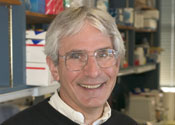 |
 |
 |
 |
 |
Mitchell Sogin, Ph.D.
Photo credit: T. Kleindinst
|
Mitchell Sogin examines a bacterial culture.
Photo credit: T. Kleindinst
|
Julie Huber, Ph.D.
|
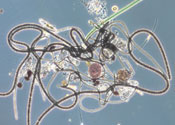 |
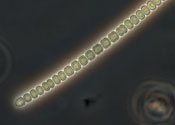 |
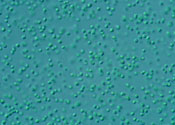 |
A collection of marine microbes. The darkest ones are a very common filamentous bacterial form that at present have not been formerly identified in scientific literature. The large pink ovoid is a cell of Chromatium a purple sulphur bacterium, the green is a cyanobacterium. The curving structure at about 2 o’clock is a diatom (Nitzschia), which is a photosynthetic eukaryote. Photo credit: D. J. Patterson, L. Amaral-Zettler and V. Edgcomb, 2006. Courtesy of micro*scope.2006.
|
This is one of two photos showing cyanobacteria that are commonly found in the world's oceans. This filament was observed in sandy and muddy marine sediments in the vicinity of Broome, Western Australia.
Photo credit: S. Murray, M. Hoppenrath, J. Larsen, D. Patterson. Courtesy of micro*scope.
|
Prochlorococcus marinus, a tiny globular cyanobacterium. This type of organism is extremely abundant in the tropical and warm temperate regions of the open oceans, and some scientists claim it is the most abundant organism on earth. It is responsible for as much as 50% of carbon fixation in the oceans.
This image is of material from Provasoli-Guillard National Center for Culture of Marine Phytoplankton, images taken by David Patterson and Bob Andersen. Image copyright: Bob Andersen and D. J. Patterson. Image used under license to MBL (micro*scope).
|
|
|
|
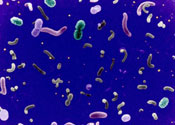 |
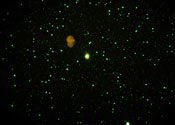 |
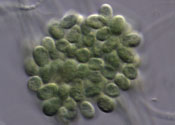 |
Diverse community of bacteria from a water sample. Photo credit: Bob Morris. Courtesy of micro*scope.
|
Marine microbes are so plentiful in this image that they resemble the number of stars in a "night sky." Photo credit: Jed Fuhrman, University of Southern California.
|
Another example of cyanobacteria. This group of cells was observed in sandy and muddy marine sediments in the vicinity of Broome, Western Australia.
Photo credit: S. Murray, M. Hoppenrath, J. Larsen, D. Patterson. Courtesy of micro*scope. |
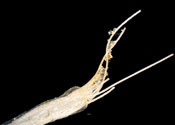 |
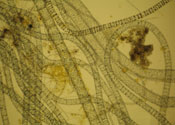 |
Thioploca araucae. Thioploca was found in seven of eight samples but at very low concentrations. It is an example of an organism that was rare in the study's sampling area but which is more prevalent in the oxygen minimum zone. Photo Credit: Victor Gallardo, Carola Espinoza, Center Copas, Universidad de Concepcíon, Chile, 2006.
|
|
Maps of Sampling Locations (courtesy of Google Maps)
Atlantic Ocean Sampling Sites
Pacific Ocean Sampling Sites
Additional Background:
Microbe Experts Available for Comment:
Funders:
- NASA Astrobiology Institute: The NAI, founded in 1998, is a partnership between NASA, 12 major U.S. teams and six international consortia. NAI's goal is to promote, conduct, and lead integrated multidisciplinary astrobiology research and to train a new generation of astrobiology researchers.
- The Woods Hole Center for Oceans and Human Health (COHH): The mission of the Woods Hole Center for Oceans and Human Health is to improve the public health through enhanced understanding of how oceanic processes affect the distribution and persistence of human pathogens and toxin producing organisms. The Center is jointly funded by the National Science Foundation (OCE-0430724) and the National Institute for Environmental Health Sciences (P50 ES012742).
- The Alfred P. Sloan Foundation: The Alfred P. Sloan Foundation, founded in 1934, makes grants to foster advances in science, technology and the quality of American life.
|